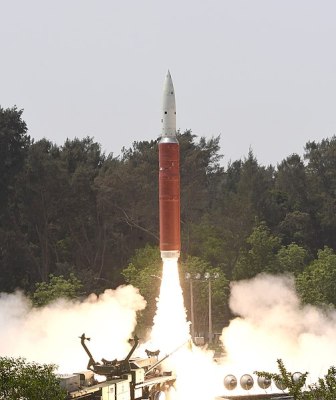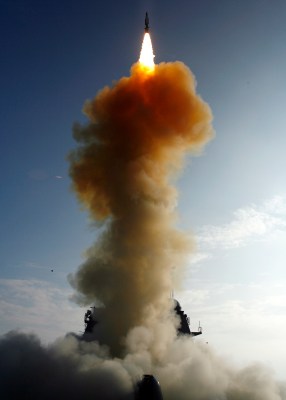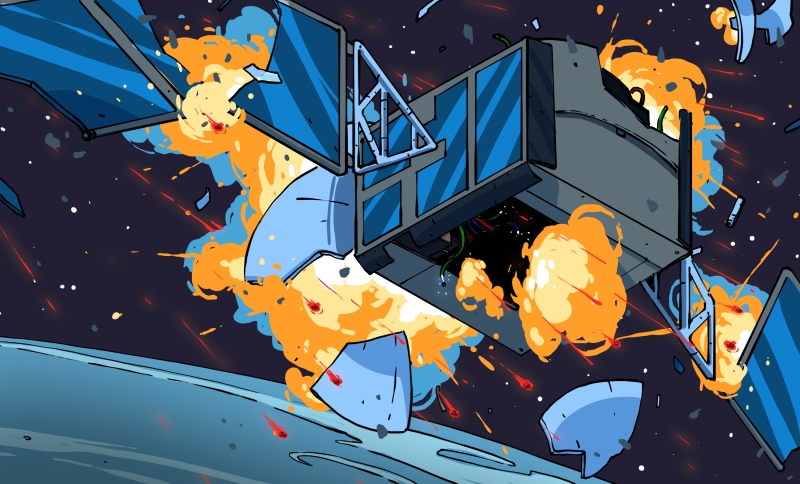On the morning of November 15, a Russian missile destroyed a satellite in orbit above Earth. The successful test of the anti-satellite weapon has infuriated many in the space industry, put astronauts and cosmonauts alike at risk, and caught the attention of virtually every public and private space organisation on the planet.
It’s yet another chapter in the controversial history of military anti-satellite operations, and one with important implications for future space missions. Let’s examine what happened, and explore the greater context of the operation.
Analysis from several sources indicates that an anti-satellite weapons system destroyed a Russian satellite designated COSMOS 1408. The satellite served in an electronic and signals intelligence role for the Soviet Union, and was launched in 1982 with an expected mission life of six months. The 2,200 kg satellite had been defunct for decades, and was sitting in Low Earth Orbit at an altitude of approximately 480 km.
US Space Command have since released a statement, indicating that Russia fired a direct-ascent anti-satellite missile which struck COSMOS 1408. The findings were independently verified by a number of private-sector space organisations, including LeoLabs and Seradata.
Exact details are hard to come by, but suspicions centre around the use of the Russian PL-19 Nudol missile for the test. The PL-19 is a ground-launched missile which has been seen in testing as recently as last year, and has anti-ballistic missile applications in addition to the anti-satellite role. The two missions share similar requirements – the need for a missile with high delta-V and high maneuverability in order to hit fast-moving targets at orbital altitudes. It’s not Russia’s only recent anti-satellite project, either, with the country reportedly recently testing a satellite designed to kinetically attack other satellites in orbit.
YouTube video: Data captured by LeoLabs indicates the debris field from the anti-satellite weapon test passing near to the orbit of the International Space Station (ISS).
The test quickly drew widespread condemnation from much of the space community. Perhaps most notably, according to a statement from NASA. astronauts and cosmonauts aboard the ISS were instructed to shelter in place. The team onboard donned their spacesuits, closed hatches to some radial ISS modules, and boarded the SpaceX Crew Dragon currently docked with the space station. These measures were taken for the first few passes through the debris field generated by the test, before NASA deemed the situation safe. As reported by multiple sources, hatches between the US and Russian parts of the space station remain open. Notably, two of the seven people aboard the space station are Russian cosmonauts, who were also placed at risk by the Russian test.
NASA administrator Bill Nelson expressed anger with a statement noting that he was “outraged by this irresponsible and destabilizing action. With its long and storied history in human spaceflight, it is unthinkable that Russia would endanger not only the American and international partner astronauts on the ISS, but also their own cosmonauts. Their actions are reckless and dangerous, threatening as well the Chinese space station.”
The problem with such testing is the huge amount of debris generated, which places other spacecraft at risk from damage or destruction. Reports from US Space Command indicate that the test generated over 1500 trackable pieces of debris, and likely “hundreds of thousands” of smaller pieces of debris that are too small to be monitored with current technology.
Present estimates indicate that the debris could remain in orbit for years, if not decades, threatening spacecraft in a wide orbital region that’s heavily used by existing spacecraft. The ISS orbits generally around 300 km – 400 km, and took aforementioned precautions around the debris field. SpaceX Starlink satellites orbit around 550 km, incidentally, a low orbit chosen so that they’ll deorbit and burn up after their service life is over to avoid adding to the problem of space junk in LEO. The Hubble Space Telescope orbits at 540 km, and the Chinese space station Tiangong similarly orbits between 340-450 km.

A similar test by India in 2019 drew ire as well, though by virtue of occurring at a lower altitude and with less political context, perhaps was not quite as poorly received as today’s Russian test. Current modelling suggests that most of the fragments from the Indian test, which destroyed the Microsat-R satellite at an altitude of 270 km, would deorbit relatively quickly, within the next few years.
Conversely, a Chinese test in 2007 targeted the FY-1C weather satellite at a much higher altitude of 865 km, leaving debris in a much higher orbit. Over half of the debris from the test still orbits above 850 km, and is expected to remain in orbit for decades or centuries to come. In 2011, a piece of the destroyed satellite passed within six kilometers of the ISS, highlighting the very real dangers of such activity.
The Soviet Union (later Russia) and the United States have both run significant anti-satellite weapons development programs since the dawn of the space era. Each side has tested a variety of approaches, taking in everything from ground-launched and aircraft-launched missiles, to laser systems and other fancier ideas such as satellites that could take down other satellites kinetically or by other means.

Meanwhile, the most recent publicaly-known test from the United States involved the use of an RIM-161 Standard Missile 3 missile to shoot down a failed National Reconnaissance Office satellite designated USA-193, in 2008. The RIM-161 missile was designed for an anti-ballistic missile role, making it well-suited to the anti-satellite mission. The stated reason for the destruction was that the satellite was deemed to be a hazard, carrying 1,000 pounds of toxic hydrazine fuel that could threaten human lives if reentry happened over a populated area.
However, Russian statements claimed that the hydrazine fuel was merely an excuse to test an anti-satellite weapon in the wake of the Chinese test in 2007. Speculation at the time was that this could lead to a new arms race in space.
The US, Russia, India, and China have successfully tested ASAT weapons, with sour enough results already. In any case, with today’s active test of a Russian ASAT weapon, as well as many rumblings of other anti-satellite tests in recent years, it seems that space may now be more weaponized than ever. Such activity poses a major risk to all spacefaring activities, and many will hope that testing quickly ceases once all countries involved are done proving their points and rattling their sabres. As always, time will tell.
















I wonder whatever happened to the treaty that declared space to be off limits to such asinine stupidity?
Asinine stupidity laughs at your puny human treaties.
Nobody ever actually signed a treaty. You’d think it reasonable that outer space was not used for such purposes. No nation is willing to actually commit to this. Irresponsible? Surely. What about Starlink? Many hundreds and possibly 10,000 of them disrupting space navigation and astronomy. People need to tone down the greed and stop shooting at each other. We’ve only had a couple thousand years to become civilized. Not going to happen in my lifetime.
Whew! Good thing we put them in “orbit” so we’d know where they were. ;-)
The great thing about the starlink is that they are in low enough orbit that if they are no longer activity maintained the Earth’s gravity will suck them in and burn them up. The Russian space junk created by this this missile test could persist for hundreds of years.
It was pretty low when they hit it, so most of it won’t last that long. Still stupid though…
I’d also agree the Starlink’s and GPS, TV sats are not really a problem while they are maintained, and all the really low stuff like Starlink, and any more modern satalite has a predefined safe termination plan from launch – some are just push to graveyard orbits, but that is still safely out of the way.
“It was pretty low when they hit it, so most of it won’t last that long.”
Actually, it was above the ISS orbit, which isn’t that low. That’s why there’s a big beef about it. It’s a continuously manned spacecraft. As the debris orbit degrades it will cross the ISS orbit. Debris items large enough to track are already only 20km above the station’s orbit. The US and Chinese ASAT tests of the past were lower. This is all detailed here:
https://www.youtube.com/watch?v=mvdQcDDUV1o
I don’t quite follow this, since it seems like they’re in a higher orbit than the ISS and the satellite that got destroyed here. Sure, they’re lower than GEO, but it looks like they’re actually higher than lots of useful things which is definitely not what was implied. If starlink cleans up after itself, this mess will too, even faster, right?
Since the destroyed satellite was broken up pieces would have gone in all directions and many pieces, while too small to track, could still bring down the ISS and other satellites. Closing speeds could be up to 30k mph.
Yes, they did. Included in the treaty is a ban on testing weapons.
I guess it’s been forgotten about by certain powers…
https://en.wikipedia.org/wiki/Outer_Space_Treaty
I’d expect, if pushed, the Russian response would be “The Outer Space Treaty? We never signed that. It was signed by the Soviet Union, not the Russian Federation. And as you may have noticed, the Soviet Union doesn’t exist anymore.”
Except, y’know, in Russian.
From what I understand, they had a chance to denounce soviet era treaties at the time that the federation succeeded the soviet union. Any treaty not denounced by the new government is considered still valid.
Regardless, the only provision in the treaty they technically violated, was to avoid harmful contamination of space and celestial bodies. How one defines harmful im sure can be debated.
If any country really wanted to show their technological superiority in space, maybe they could exactly match orbit of an existing satellite capture it and execute a controlled targeted de-orbit into the Spacecraft cemetery (South Pacific Ocean Uninhabited Area). That would actually be impressive.
… how Bond-esque. :D
“No Bound, I expect you to die by ballistic missile.”
I thought that was John Steele
https://evilgenius.fandom.com/wiki/John_Steele
“No, Mr. Bond. I expect you to burn up on reentry.”
If any country really wanted to show their technological superiority in space they would go up and clean up. And not ask for applause afterwards.
Children are allowed to play and leave a mess, but adults clean up after them enough to ensure that they don’t hurt themselves.
:+1:
you might enjoy this show
https://www.imdb.com/title/tt0816398/
planetes.
You are assuming these people are adults rather than just over-grown up children with bigger, more expensive toys.
Besides, it could all be a conspiracy to prevent the future manned missions to the Moon etc. by making sure the is enough debris that safe travel out of orbit is statistically more difficult.
were not innocent in all this. we had to create a new military branch dedicated to space warfare. russia and china as well (that hypersonic missile test) are simply responding to the show of force we made. russia is saying ‘anything you launch we can kill’. china is saying ‘we dont need space to nuke you’. its just sabre rattling, the kind we had before the first space race. we will be intering into a boom, either technological or nuclear. maybe we can get that orion drive this time and have a little of both.
That is a terrible plan. The debris not only prevents human spaceflight, but also communication satellites, weather satellites, and of course important-to-the-military GPS and spy satellites.
suborbital interceptors are cheaper.
Russia run some preliminary testing a while ago https://time.com/5779315/russian-spacecraft-spy-satellite-space-force/
The title should have been “Russian attempt to lock the entirety of humanity on earth for thousands of years by dumping hypersonic debris into orbit” That would get across how dangerous this actually was. Kessler Syndrome works almost exactly like a MLM wants to work, it only requires a seed to start propagating.
“Russia joins China and USA attempts to lock us in” has a nice ring to it too. There’s a nice documentary (Idiocracy) on where things are going right now.
US shot down a satellite at much much lower altitude. All debris disappeared in around 40 days.
And now we know the Russians can easily knock out our GPS satellites.
and their own glonass to boot, as the debris field does not discriminate.
No, not really. You can’t extrapolate that far. GPS satellites are 20 times further away than this one was. And you’ll have to take out more than just one to seriously degrade the system.
Sure but it’s nothing new, the Soviets’ wacked a satellite in orbit back in ’68. From the sounds of this one, the satellite they hit isn’t exactly a small target (as satellites go, maybe I’m wrong here), so this doesn’t seem to have accomplished anything besides remind the world that they still have these anti-sat weapons and turns out, they’re still in good enough shape to do their job. Classic cold war saber rattling, except with the added risk of Kessler syndrome and accidentally killing their own cosmonauts on the ISS.
Exactly. This is “news” from the beginning of space era.
They are by no means the only country to have the capability or even to have tested it. Many countries now have satellites capable of attacking other satellites directly and defending against attack autonomously, not just avoiding obstacles by obeying commands from the ground and keeping themselves in orbit. Things like this are only going to become more public as time goes on and we have a greater presence in space because the communication will be harder to keep tightly controlled.
You probably don’t even realize the depth and breadth of ignorance this statement reveals.
planetes was a great show.
https://youtu.be/Hfnn1U7j5Qc
this video/show is relevant to the topic.
hopefully we humans can keep our local space field clean so safe operations may continue for all.
So, finally an explanation on how the movie “Gravity” starts?
+1
South Pacific Ocean Uninhabited Area, so that’s where the hole is in the greater Earth gravity toilet! Kwishsss.
The truth of the matter is that this was not just a missle destroying an old satelite as a test. The US has been deploying (and re-positioning) spy satelites in close orbit to other known, non-funtioning, satellites for years as a sort of cat and mouse game. This was a very special message to sent with a very special courrier. I don’t know what asset was blown to smitherines along with the russian sat, but suffice to say it was not just their own old satellite they wanted to eliminate.
That’s an interesting angle I hadn’t heard elsewhere. Do we know what object you’re referring to? I was under the impression that amateurs (and semi amateurs) have gotten pretty good at determining orbital elements of just about anything you can see from earth.
Everybody is in on that game. Kosmos 2542 has been hanging out with USA 245 since January 2020. China put Shijan 20 on 271 this past summer with some pretty delicate ballet moves.
“I say we lift off…. nuke ’em from orbit… It’s the only way to be sure” (Private Hudson – Aliens)
*Dude*. It was Ripley first and then Hicks later on. Hudson said “Now I’m going to buy it on this rock”.